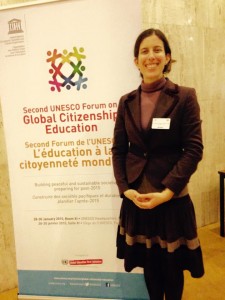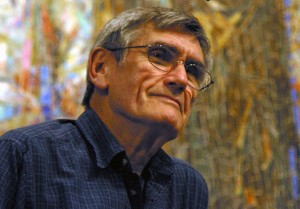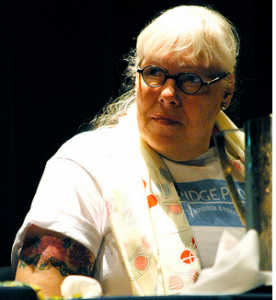
Nonviolence on the International Education Agenda
From January 28-30, 2015, I had the opportunity to participate in UNESCO’s Second Forum on Global Citizenship Education (GCED), which was held in the lead up to the World Education Forum (WEF). At the WEF, the educational goals for the post-2015 development agenda will be established, following the Millennium Development Goals that end this year. Over 250 participants from all regions of the world, including educators, academics, policy makers, government officials, civil society representatives, gathered at UNESCO’s headquarters in Paris to discuss recommendations for how global citizenship should be included in the international education agenda.
In the working draft of the proposed Framework for Action, Goal 4 deals with education, and states that member states should ensure “inclusive and equitable quality education and promote lifelong learning opportunities for all.” Global citizenship – and nonviolence – are specifically mentioned in target 4.7:
“By 2030, ensure that all learners acquire the knowledge and skills needed to promote sustainable development, including, among others, through education for sustainable development and sustainable lifestyles, human rights, gender equality, promotion of a culture of peace and non-violence, global citizenship and appreciation of cultural diversity and of culture’s contribution to sustainable development.”
But what do we mean by global citizenship education? UNESCO describes GCED as “values, knowledge and skills that are based n and instill respect for human rights, social justice, diversity, gender equality, and environmental sustainability and that empower learners to be responsible global citizens.” This may also sound like peace education or sustainable development education, or one of the many fields of education which strive for transformation of oneself and the world. In the UNESCO guide on GCED, Toh Swee-Hin explains it as such:
“Important entry points for GCE are peace education, human rights education, education for international understanding, and education for sustainable development. They are like a river with many tributaries: in this river we can mix and learn from each other.”
Rather than viewing these as separate fields of education, they are interrelated and overlapping, all seeking the outcome of transformation towards a just, peaceful, sustainable, nonviolent world. While they may differ slightly in approach and focus, they share greatly in what they offer in terms of knowledge, skills, values, and also the pedagogy through which they are taught. They also emphasize lifelong learning, and the need for education opportunities at the formal, nonformal (community-based) and informal (media, parenting, etc.) levels.
Right now, there is energy and enthusiasm for global citizenship education at the United Nations among some member states, notably South Korea, Austria and Oman (who supported the meeting). UNESCO is in the process of developing a guide of teaching and learning objectives for policymakers and educators that will help them implement GCED at the national level.

As the policy rapporteur for the meeting, I was responsible for taking extensive notes during the plenaries and concurrent sessions, and then summarizing the key recommendations in a ten-minute presentation on the last day of the conference, along with the rapporteurs on implementation and partnerships (you can find the slides here).
One of the key findings for policy that came up repeatedly was the need for teacher training (both pre- and in-service) to be included and emphasized in policy, and to support this, the need for creating institutes and programs for GCED leadership (such as masters degrees in GCED). Another strong theme throughout the conference was the meaningful, authentic inclusion of youth in all levels of decision making regarding their education. Additionally, there was a call for a broader base of stakeholders to be included in the policymaking process, such as teachers, parents, students, and other members of the community. We heard of one example from Central America of how this was conducted over a period of 8 years, which gives hope that such an inclusive process can in fact be implemented in spite of challenges.
One of the most inspiring parts of the event for me was hearing from representatives from different countries that have related national policies, such as for peace education. Kenya, for example, has a national policy for peace education that came about after the 2007-2008 election violence. Colombia also recently mandated that peace be taught in all schools. Both of these initiatives came about in light of violence experienced in those countries (the post-election violence and civil wars, respectively), and I found myself wishing that in the US, we could respond to our own violence in such a constructive way. These examples provide us with many lessons learned, from how the policies came to pass, to what has worked well, as well as the challenges. While gaps remain between the policy and implementation, these policies are still quite new and give hope for the potential of mainstreaming peace education (and related education) in schools.
One of the highlights of the conference for me was a comment during our last open session Q&A from Dr. Peter deSouza of the Centre for the Study of Developing Societies in Delhi, who opened the forum’s first plenary with his thought-provoking talk on “Revisioning Education in Today’s World.” Dr. deSouza brought to our attention that it was the anniversary of Gandhi’s assassination, and we should explicitly commit to nonviolence as one of the universal principles for global citizenship, and better yet, to use the original Sanskrit in the document, as some of the meaning gets lost in translation. While nonviolence is included in target 4.7, it had not been discussed at the forum in the context of GCED. Throughout the forum, participants had agreed that a set of universal principles for GCED needed to be established (such as gender equality, respect for human rights, etc.), which could then be adapted for local contexts.
The gap between policy and practice was a persistent theme, and at times I think we were all wondering what such lofty goals mean if we always fall short of reaching them (we have not fulfilled the MDGs, for example). However, one participant pointed out that although we may not reach the goals in the time we had hoped, these policies point us in the right direction and tend to hasten change to that effect. If we are able to take steps closer to making Target 4.7 a reality, I truly believe we will also be on our way to a more just, peaceful, sustainable world.














 As an intern at Metta Center, Mercedes Mack supports our mission in a variety of ways: she writes insightful, context-filled posts for our
As an intern at Metta Center, Mercedes Mack supports our mission in a variety of ways: she writes insightful, context-filled posts for our 